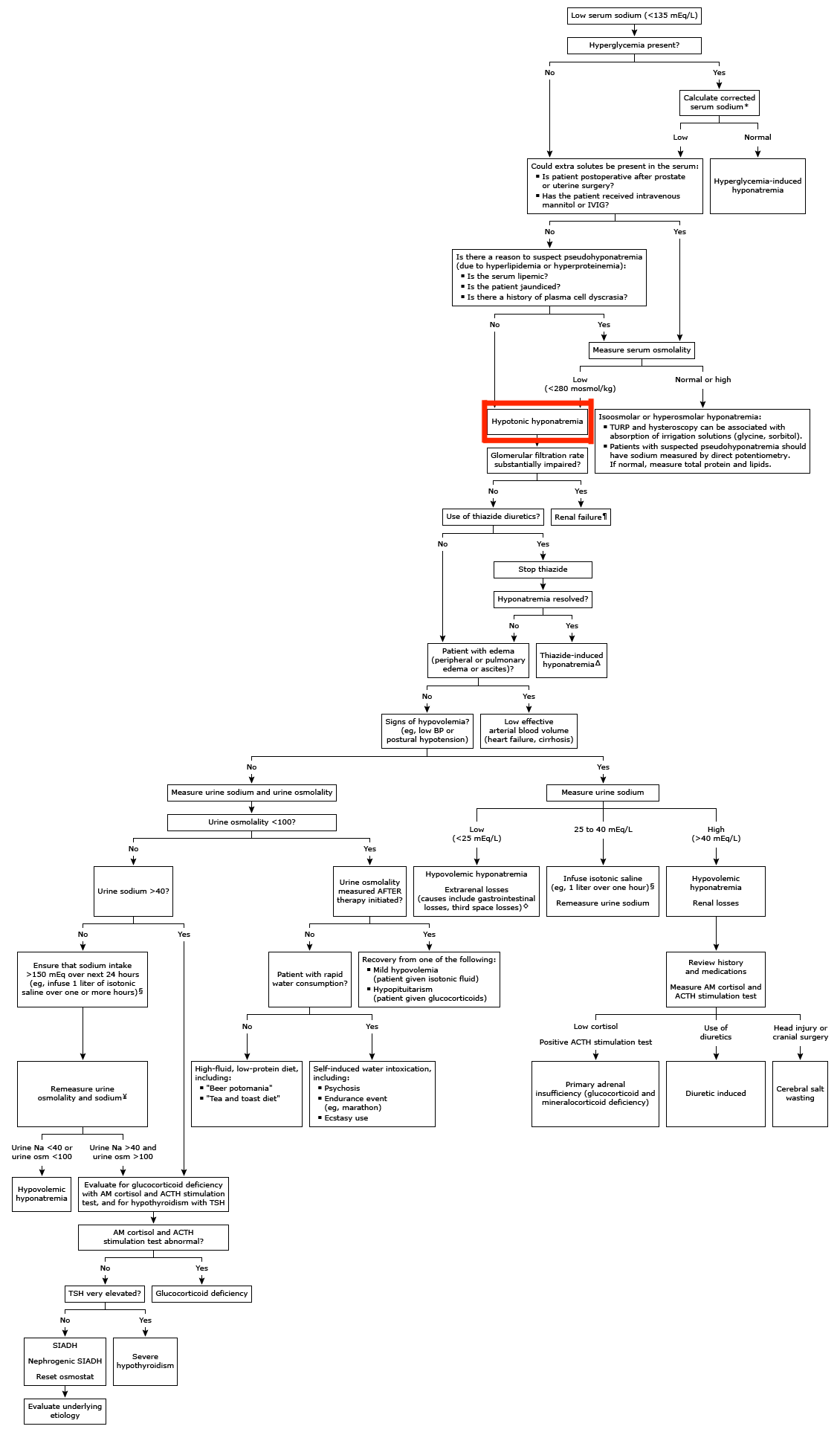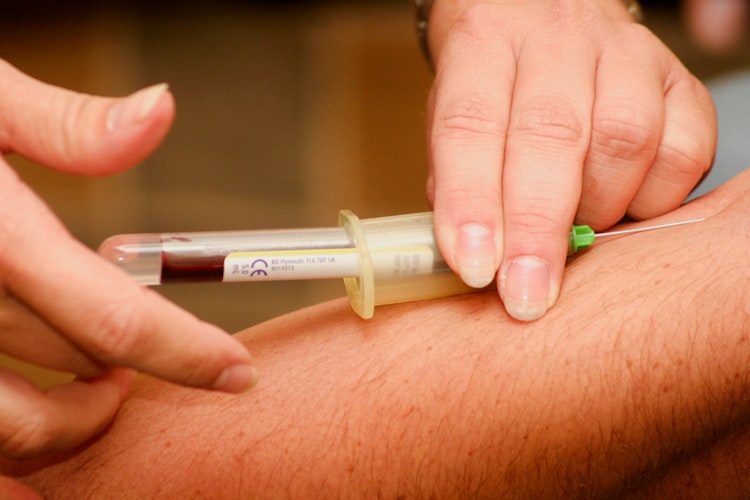Hyponatraemia

High-Yield Tips
- Always check Therapeutic Guidelines or your local guidelines prior to actually dosing a patient (as this information may be out of date by the time you read it)
- Determine whether the patient has symptoms
- Determine whether it's a hypertonic, isotonic or hypotonic hyponatraemia (primarily through history and investigations)
- SEVERE HYPONATRAEMIA (SERUM [SODIUM] < 120 mmol/L) IS LIFE-THREATENING!
- If hypotonic (which is the most common), determine whether it's hypervolaemic, euvolaemic or hypovolaemic hyponatraemia (primarily through clinical examination)
- Potentially useful investigations to order:
- VBG (initial serum [sodium] measurement)
- BSL
- Serum osmolality
- FBC, UEC, LFTs (protein + bilirubin), lipids
- Urine osmolality
- Urine sodium
- TSH
- Serum EtOH level
- Management
- NEVER INCREASE SERUM [SODIUM] BY > 8 mmol/L IN 24h AS YOU MAY CAUSE OSMOTIC DEMYELINATION SYNDROME!
- If severe, CALL FOR HELP, hypertonic saline 3% (100 mL bolus over 10 mins, max 3 boluses, aiming 4-6 mmol/L increase in serum [sodium]) + escalate to ICU + treat underlying cause (as a junior, you should not be managing this on your own)
- If mild to moderate:
- Daily UECs + monitor fluid balance + if:
- Hypervolaemic or euvolaemic: fluid restrict to 500-1000 mL
- Hypovolaemic: give IV 0.9% sodium chloride
- Treat underlying cause
- Daily UECs + monitor fluid balance + if:
- Reference ranges
- Serum [sodium]: 135-145 mmol/L
- Serum osmolality: 275-295 mmol/kg
- Urine osmolality: 50-1200 mmol/kg
- Urine sodium: 75-300 mmol/24h
Definition
Hyponatraemia is defined as a serum sodium concentration < 135 mmol/L.
Note: you may see me refer to serum sodium concentration as serum [Na] or serum [sodium] throughout this article; both are equivalent.
Classification
Hyponatraemia can be stratified into 3 risk categories based on serum sodium concentration:
- Mild: 130 ≤ serum [Na] < 135
- Moderate: 120 ≤ serum [Na] < 130
- Severe: serum [Na] < 120
Note: some sources say < 125 is severe while others say < 120. I've chosen < 120 here because that seems to be the most frequently reported value.
Epidemiology
- Most cases of hyponatraemia are hypotonic
Clinical Presentation
Patient symptoms may also help with identification and risk stratification of hyponatraemia:
- Mild: usually asymptomatic, but may have some moderate Sx
- Moderate: nausea (without vomiting), confusion, headache, malaise, muscle cramps
- Severe: vomiting, cardiorespiratory failure, drowsiness, convulsions, coma
Aetiology & Diagnostic Approach
A quick note on terminology
This is semantics, but because I now understand it I'm making a quick note on it here, but this section is not that high-yield.
You might've come across the terminology breaking down the causes of hyponatraemia by serum tonicity OR by serum osmolality. For example:
- Hyper-osmolar (?aka hypertonic)
- Iso-osmolar (?aka isotonic)
- Hypo-osmolar (?aka hypotonic)
Now, these terms are not strictly interchangeable, but practically-speaking they are (in most cases).
Serum tonicity (aka the effective serum osmolality) is defined on UpToDate as:
the serum concentration of solutes that do not easily cross cell membranes (mostly sodium salts with a small contribution from glucose and potassium) and therefore affect the movement of water between cells and the extracellular fluid.
In contrast, serum osmolality:
also includes the osmotic contributions of urea and (if present) ethanol or other alcohols or glycols, which are considered "ineffective" osmoles since they can equilibrate across the cell membrane and therefore have little effect on water movement.
Why does this matter?
There are two specific cases where the serum osmolality may suggest a diagnosis of hypertonic or isotonic hyponatraemia, but in reality the patient has hypotonic hyponatraemia:
- Hyperuricaemia (azotaemia)
- Recall urea is an ineffective osmole and so if the patient has elevated urea (e.g. secondary to advanced renal disease), their serum osmolality may be high or normal, but their tonicity is actually low. Thus, these patients should be managed as hypotonic hyponatraemia (refer to Management below).
- Alcohol intoxication
- Recall ethanol is another ineffective osmole and so if the patient has elevated serum EtOH, their tonicity may be lower than what their serum osmolality displays. Thus, these patients should be managed as hypotonic hyponatraemia (refer to Management below).
So how do we know what the tonicity is?
We use some equations.
UpToDate recommends the following:
- Urea: tonicity = measured serum osmolality - blood urea concentration (where urea is measured in mmol/L)
- EtOH: tonicity = measured serum osmolality - ([ethanol] / 3.7)
Another way to think about this whole tonicity vs osmolality thing is that tonicity is what you're actually treating... it's what's actually important. On the flipside, serum osmolality is what we're measuring because it's a good proxy for tonicity, but as we've seen, it has its issues.
Step 1: Determine serum tonicity
How?
By measuring serum osmolality.
Why?
To differentiate between hypertonic, isotonic and hypotonic hyponatraemia.
First let's look at the causes of hypertonic and isotonic hyponatraemia.
Hypertonic (or isotonic) hyponatraemia
- Hyperglycaemia
- IV mannitol
- IV immune globulin (IVIG)
- IV sucrose / IV maltose
- IV radiocontrast dye
- Surgical irrigants (e.g. glycine → TURP syndrome)
Isotonic hyponatraemia only (aka pseudohyponatraemia)
- Hyperlipidaemia
- Hyperprotinaemia (e.g. patients with a plasma cell dyscrasia)
- Obstructive jaundice
To differentiate between these, use common-sense + history + investigations (e.g. BSL, lipids, LFTs for protein and bilirubin) when required.
Note: pseudohyponatraemia is when the serum sodium concentration is measured to be low when in actual fact it is normal. This is usually due to laboratory issues: there is such high protein or lipoprotein count that when the sample is measured by the analysing machine (which requires precise volumes), the protein/lipoprotein displace the 'aqueous' amount containing the sodium, leading to a falsely low reading.[1] You might see hyperglycaemia-induced hyponatraemia also be classified as pseudohyponatraemia (e.g. in the LITFL diagram below), but this is incorrect imo. In hyperglycaemia-induced hyponatraemia, the high extracellular glucose also draws water extracellularly, which dilutes the serum [Na] leading to ↓ serum [Na] and though there is not a total deficit in body sodium, as we previously defined, the serum [sodium] is < 135 mmol/L and the machine is correctly measuring this.
If the patient is identified to have one of the above, you can move straight to management. If they appear to have hypotonic hyponatraemia, proceed onwards.
Step 2: Ascertain cause of hypotonic hyponatraemia
As previously mentioned, hypotonic hyponatraemia causes the vast majority of cases, therefore we must rule these other causes out as we're going along and so thinking about isotonic and hypertonic causes first makes logical sense to me.
Once we know the serum tonicity is low, we need to assess the patient's fluid/volume status using history and examination and further investigations to categorise the patient as either:
- Hypovolaemic
- Euvolaemic
- Hypervolaemic
Each of these fluid statuses has their own associated causes:
- Hypovolaemia
- Urinary sodium > 20 mmol/L
- Renal loss: diuretics, mineralocorticoid deficiency
- Urinary sodium ≤ 20 mmol/L
- Extrarenal loss: vomiting, diarrhoea, third spacing, bowel obstruction
- Urinary sodium > 20 mmol/L
- Hypervolaemia
- Urinary sodium > 20 mmol/L
- Renal failure
- Urinary sodium ≤ 20 mmol/L
- Heart failure, liver cirrhosis, nephrotic syndrome, hypoalbuminaemia
- Urinary sodium > 20 mmol/L
- Euvolaemia
- Urine osmolality > 100 mOsm/kg
- SIADH (drug-induced; cerebral or pulmonary pathology; malignancy-associated), hypothyroidism, adrenal insufficiency, stress
- Urine osmolality ≤ 100 mOsm/kg
- Primary polydipsia, high-fluid + low-protein diet (e.g. beer potomania syndrome, 'tea and toast' diet)
- Urine osmolality > 100 mOsm/kg
If you're looking for a different way to approach it, here's the UpToDate flowchart that is widely used by med regs:

Management
Treatment depends on the duration, severity and presence of symptoms of hyponatraemia, as well as the presence of preexisting intracranial pathology e.g. TBI, SOL).
Acuity
- Acute hyponatraemia is defined to have developed over a period of < 48h. It usually results from parenteral fluid administration in post-op patients (who have post-surgical SIADH) and from self-induced water intoxication (e.g. runners, MDMA users)
- Chronic hyponatraemia is defined to have developed over a period ≥ 48h OR if the duration is unclear (e.g. patients who develop hyponatraemia at home)
UpToDate summarises the importance of acuity nicely:
The more acute the hyponatremia, the greater the risk of complications (such as cerebral edema and seizures) and the greater the need for aggressive therapy. The more chronic the hyponatremia and the lower the serum sodium concentration, the greater the risk of complications from overaggressive therapy and the greater the need for monitoring to avoid overcorrection.
Goals of Therapy
- Prevent a further decline in serum sodium
- Prevent brain herniation
- Brain herniation typically occurs in the following settings:
- Acute hyponatraemia due to massive water ingestion
- Women and children with acute postoperative hyponatraemia
- Hyponatraemic patients with intracranial pathology
- Brain herniation typically occurs in the following settings:
- Relieve symptoms of hyponatraemia
- Most symptoms, even severe symptoms, can be relieved by a 4-6 mmol/L increase in serum sodium during the first 24h. If symptoms persist after an increase of this magnitude, there is no benefit of correcting at a faster rate.
- Avoid overcorrection
- THE MAXIMUM RATE OF CORRECTION SHOULD BE 8 mmol/L in any 24h period
- Overly rapid correction of severe, chronic hyponatraemia can lead to Osmotic Demyelination Syndrome (ODS; previously known as central pontine myelinolysis)
- Factors that ↑ risk of ODS include: hypokalaemia, alcholism, malnutrition, advanced liver disease
The Actual Management [5]
Note: the Australian guidelines vary vastly from what UpToDate recommends, so what I've included is directly from Therapeutic Guidelines.
For mild to moderate hypervolaemic or euvolaemic hyponatraemia:
- Fluid restriction (e.g. 500-1000 mL per 24h OR 500 mL less than daily urine output)
- Daily or twice daily bloods (UECs)
- Urine output monitoring and fluid balance
For mild to moderate hypovolaemic hyponatraemia:
- IV 0.9% sodium chloride
- Rate and amount depends on patient
- Cessation of any contributing medications (e.g. thiazide diuretics)
- Bloods (UECs) daily
- Fluid balance
For severe hyponatraemia, of any cause, based on presence of cerebral symptoms or serum [sodium] < 120 mmol/L:
- Escalate to intensive care for monitoring
- IV 3% 100 mL sodium chloride over 10 minutes. Repeat as needed up a maximum of 3 infusions.
- Goal: to raise serum [sodium] by 4-6 mmol/L to prevent brain herniation
- To determine the rate of infusion, there's an excellent sample calculation on Therapeutic Guidelines
FAQs
- What is the difference between cerebral salt wasting (CSW) and syndrome of inappropriate anti-diuretic hormone secretion (SIADH)?
- One similarity they share that may lead to confusion is that both SIADH and CSW are causes of hyponatraemia in patients with cerebral disease, with the latter being notably present in those with subarachnoid haemorrhages. Additionally, both pathophysiological mechanisms involve elevated levels of ADH.
- In terms of how they differ, firstly the mechanism of hyponatraemia in CSW is that ↑ ICP → ↑ release of BNP → ↓ renal sodium reabsorption + ↓ renin release → renal salt wasting → hypovolaemia → baroreceptor stimulus for release of ADH → water retention → hypovolaemic hyponatraemia. In contrast, as the name suggests, SIADH is caused by an inappropriate secretion of ADH, causing water retention and dilutional hyponatraemia. Secondly, SIADH causes euvolaemic hyponatraemia whereas CSW causes hypovolaemic hyponatraemia and thus their management differs.
Resources
- What is pseudohyponatraemia
- UpToDate: Causes of hyponatremia without hypotonicity (including pseudohyponatremia)
- UpToDate: Diagnostic evaluation of adults with hyponatremia
- UpToDate: Overview of the treatment of hyponatraemia in adults
- Therapeutic Guidelines: Hyponatraemia
- RCPA: Osmolality
- RCPA: Osmolality Urine
- RCPA: Sodium Urine
- UpToDate: Cerebral salt wasting





